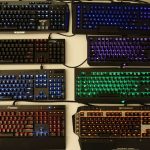Gaming keyboards have been around for a long time. They have often featured gimmicks like extravagant styling or trivial functions. However, there are important keyboard elements that can definitely improve performance or create more comfortable and enjoyable gaming experiences.
Mechanical keyboards are a staple for PC gamers. Mechanical switches offer more precise, responsive, and consistent keystrokes, and come in all sorts of variations. But before we move on, let’s define some keyboard terminology.
Mechanical Switch: The mechanism underneath the keycap which registers a keystroke. Each key has an individual switch to send a distinct signal to register the input. Cherry MX mechanical switches are the most common among mechanical keyboards, and are color-coded to signify different features.
Actuation Point: The point at which a keystroke is registered. Different switches have different travel distances to actuate and some have a tactile bump or click to create distinct actuation feedback.
Actuation Force: The amount of force required to register a keystroke and actuate a switch. The higher the actuation force, the harder you have to press the key. This comes down to preference and how hard you type.
Tactile Click: This characteristic is most often attributed to Cherry MX Blue switches (and the less common Greens and Whites). At the actuation point, there is a distinct click. This provides keystroke registration feedback. Blue switches tend to be very loud to type and game with. It’s probably not the best keyboard to use in a quiet office environment, unless you want to drive everyone mad.
Tactile Bump: This characteristic is attributed to Cherry MX Browns (and the less common Clears). There is a noticeable bump at the actuation point that provides some keystroke feedback. It feels less distinct than the tactile click, but it is less audible and provides a middle ground between Blues and Reds/Blacks.
Linear: Linear switches have no tactile feedback. Nothing impedes keystrokes except the actuation force required. These switches provide the most effortless keystrokes and make for easier double-tapping. Both Cherry MX Reds and Blacks are linear.
For a more detailed background on Cherry MX switches, check out The Keyboard Company’s in-depth analysis.
Tenkeyless: A tenkeyless keyboard ditches the number pad to create a smaller form factor. It’s intended for those with limited desk space or have an affinity for minimalism.
Membrane: Most standard keyboards use membrane pressure pads to register keystrokes. This results in a soft and relatively quiet keystroke, but a squishy feel that detracts from precision and consistency.
Macro Key: A macro key is a key that is outside the standard layout that’s intended to be programmed for a specific action or chain of actions. For gamers, important actions can be bound to these keys for quick access to certain complex moves in games.
N-key Rollover: N-key rollover signifies that each keystroke is registered independently. This means that you’re not limited to the number of keys you can press before it becomes too much to register. All keyboards in this roundup have significantly high to unlimited rollover.
Polling Rate: How frequently your USB connection checks for inputs. Keyboards in this roundup have very high polling rates (1000Hz = detection every 1 millisecond), which is fast enough to mitigate lag.
centinewtons (cN): A measurement of force. You’ll often see grams-force (g or gf) and cN used interchangeably as they are both extremely close equivalents.
Mechanical Switch Specifications
| Switch Type | Tactile Feedback | Actuation Force | Actuation Point | Travel Distance |
| Cherry MX Red | Linear | 45 cN | 2 mm | 4 mm |
| Cherry MX Blue | Tactile Click | 50 cN | 2 mm | 4 mm |
| Cherry MX Black | Linear | 60 cN | 2 mm | 4 mm |
| Cherry MX Speed/Silver | Linear | 45 cN | 1.2 mm | 4 mm |
| Cherry MX Brown | Tactile Bump | 50 cN | 2 mm | 4 mm |
| Razer Green | Tactile Click | 50 cN | 1.8 mm | 4 mm |
| Razer Mecha-membrane | Tactile Click | Undefined | Undefined | Undefined |
| Logitech Romer-G | Linear | 45 cN | 1.5 mm | 3 mm |
| Logitech Mech-Dome | Tactile Bump | 50 cN | Undefined | 4 mm |
| Steelseries QS1 | Linear | 45 cN | 1.5 mm | 3 mm |
Each keyboard was used extensively. We also tested them with a 60-second typing test and played a round of Overwatch on each plank. We also made sure to install its proper software to test macro keys and to examine backlight effects.
With the terminology and methodology out of the way, it’s time to dig into a handful of gaming keyboards. We’ll be discussing the ergonomics, functionality, and features of each keyboard.
Prices included in this article reflect the time of publishing.
